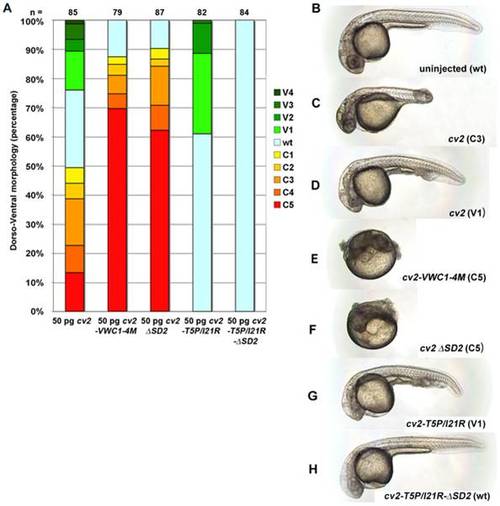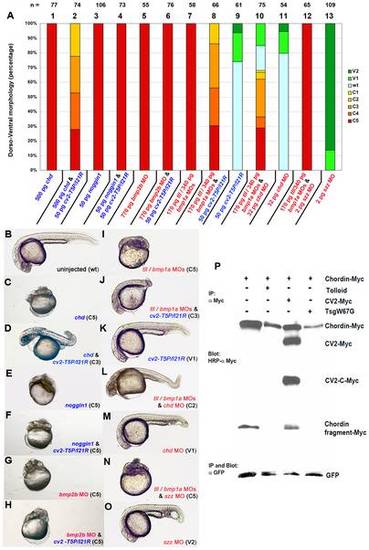- Title
-
Binding between Crossveinless-2 and Chordin von Willebrand factor type C domains promotes BMP signaling by blocking Chordin activity
- Authors
- Zhang, J.L., Patterson, L.J., Qiu, L.Y., Graziussi, D., Sebald, W., and Hammerschmidt, M.
- Source
- Full text @ PLoS One
|
Binding of CV2 to Chordin promotes BMP signaling in vivo. (A) Graphical illustration of proportions of phenotypes generated upon injection of different CV2 constructs. For classification from C5 (strong dorsalization) to V4 (strong ventralization), see Mullins et al [47] and Kishimoto et al (38). Numbers of analyzed embryos are indicated above the columns. (B–H) Representative zebrafish embryos after mRNA injections as in (A). Lateral views of live embryos at 32 hpf. |
|
The pro-BMP activity of CV2-T5P/I21R requires the presence of Chordin. (A) Graphical illustration of proportions of dorsalized and ventralized phenotypes generated upon injection of cv2-T5P/I21R or bmp2b mRNA (in blue letters), cv2, chd or nog1 MOs (in red letters), or mixtures of the mRNA/MOs in different combinations. Numbers of analyzed embryos are indicated above the columns; columns are numbered. (B–J) Representative zebrafish embryos after mRNA and/or MO injection as in (A). Right panels show overall morphology of live embryos in lateral views at 32 hpf, left panels show embryos at 80% epiboly (mid gastrula stage), after whole mount otx2/eve1 double in situ hybridizations (domains indicated in B), lateral views, dorsal to the right. The expression of the dorsal marker otx2 is reduced in ventralized and expanded in dorsalized embryos, whereas the ventral marker eve1 shows contrary shifts. EXPRESSION / LABELING:
PHENOTYPE:
|
|
CV2 can antagonize the dorsalizing effect of Chordin, but not of Noggin1, while the anti-Chordin effect of CV2 is both dependent and independent of Tolloid/Bmp1a. (A) Graphical illustration of proportions of dorsalized and ventralized phenotypes generated upon injection of cv2-T5P/I21R mRNA into wild-type embryos (lane 9), into embryos after chordin or noggin1 overexpression (lanes 1–4), or into bmp2b (lanes 5,6) or tolloid/bmp1a morphants (lanes 7,8), in comparison to the response of the tolloid/bmp1a double morphants to co-injection of chordin MO (lanes 10,11) or sizzled MO (lanes 12,13). Numbers of analyzed embryos are indicated above the columns; columns are numbered. (B–O) Representative zebrafish embryos after mRNA and/or MO injections as in (A). Lateral views on live embryos at 32 hpf. (P) Western blot detecting C-terminally-Myc-tagged Chordin (upper panel) or GFP (lower panel) in zebrafish embryos after mRNA injections. Lanes were loaded with precipitates of extracts from 50 mid-gastrula stage embryos (85% epiboly stage; 9 hpf) that had been injected at the 1-cell stage with 300 pg chordin and – as injection control - gfp mRNA per embryo, or with the same amounts of chordin and gfp mRNA, plus 600 pg mRNA encoding CV2, Tolloid or TsgW67G, respectively. Sibling embryos from the various injections had been allowed to develop further and displayed dorsalization of similar strengths at 32 hpf. In the upper blot, in addition to Chordin, Myc-tagged full-length CV2 and its C-terminal fragment CV2-C could be detected. PHENOTYPE:
|



